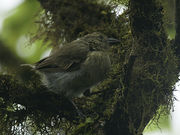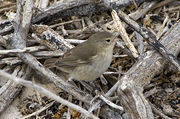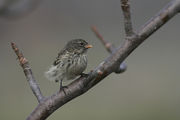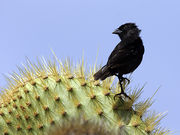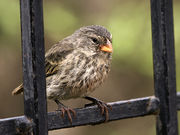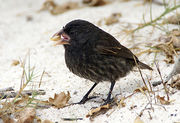Darwin's finches
Darwin's finches are thirteen to fourteen different species of finches living on the Galápagos Islands. These birds have been considered an icon of evolution ever since Charles Darwin studied them on the voyage of the Beagle in 1830. Darwin had noticed that each island had its own variety of finch. It's not mainly the fact that the birds are all about the same size (10-20 cm.) that has caused such an uproar in the scientific community among evolutionists and creationists; nor the fact that they are all about the same color. The most important differences between the species are in the size and shape of their beaks, all suited to their varying diets and lifestyles. Some have large beaks used for cracking nuts and seeds, while others have slender beaks suited for catching insects. The explanation for this given by Darwin was that all the finches on the islands came from one original pair of finches, and that natural selection is responsible for the differences. Because of the variations in the finches he inferred that all species on Earth had evolved from this process over billions of years.[1]
Charles Darwin was partially correct when he stated that living things can change. And it was probably an accurate conclusion that the finches came from one original pair. Of course, that common ancestor was still just a finch. What he did not know at the time was the limitations that organisms have in their genetic potential. He thought that all organisms had unlimited adaptive power and could transform into a completely different class of animal, given enough time and the right environment. Zoologist Harold G. Coffin said this about Darwin, "We must admit that Darwin did see different variations from one island to another in the Galápagos. And he did see evidence that made it necessary for him to discard a belief that living things did not change. But they were relatively minor and he had no compelling evidence that forced him to believe in limitless transformation. Darwin made a common mistake-- that of "either-or". Either species were fixed or unlimited change occurred. But the truth lies between the two extremes."(Perloff, pg 47)
Charles Darwin thought that natural selection caused these finches to evolve through a process of small changes over long periods of time leading to a new and better animal. He made his theory and compiled his thoughts in his book, The Origin of Species. Although this process has never produced the changes posited by Darwin, it is still considered by evolutionists as a fact that should not be disputed. What we find is that through the process of genetic diversity and mutations, living things do adapt to their environment, but they do not evolve into new and better animals. They stay within their created kinds, as it says in Genesis “. . . bring forth the living creature after his kind. . .” No organism has evolved into a new kind, even though they do adapt and change to their environment. Because of the boundaries that God set up for organisms to operate within, that is why we do not see a dog reproducing into anything but a dog, or a dolphin forming into anything but a dolphin. The DNA has its limits and all creation stays within it.[2]
In the case of the finches on the Galápagos Islands, normal variations in genetics and changes in environment are the causes of the varying beak sizes among the finches. It has been observed in times of drought that the size of the finches' beaks changed. As the supply of edible seeds diminished, only tough, hard-to-open seeds were left, and only birds with larger, deeper beaks could eat them. The generations to follow showed a dramatic increase in overall beak size in the population because only the finches with larger beaks would survive the drought and be able to mate. However, as the rains returned, a reversal of beak size was observed. The size of finch beaks tend to oscillate between large and small depending on climate changes, but the finches have never shown any signs of changing into anything other than a finch. Evolutionist Richard Goldschmidt described the difference between two types of evolution: "macro" and "micro". There is no evidence supporting macroevolution, which is conversion of one animal type into another. Microevolution is minor variation within a species, as in the case of Darwin's finches. Goldschmidt knew of this because he bred gypsy moths for more than twenty years. Throughout the million generations that he bred he never got anything but gypsy moths. He had said himself, "It is true that nobody thus far has produced a new species or genus, etc., by macroevolution. It is equally true that nobody has ever produced even a species by the selection of micromutations."[3]
Species
- Genus Geospiza
- Large Cactus-finch, Geospiza conirostris
- Sharp-beaked Ground-finch, Geospiza difficilis
- Vampire Finch, Geospiza difficilis septentrionalis
- Medium Ground-finch, Geospiza fortis
- Small Ground-finch, Geospiza fuliginosa
- Large Ground-finch, Geospiza magnirostris
- Darwin's Large Ground-finch, Geospiza magnirostris magnirostris - possibly extinct (1957?)
- Common Cactus-finch, Geospiza scandens
- Genus Camarhynchus
- Vegetarian Finch, Camarhynchus crassirostris - sometimes separated in Platyspiza
- Large Tree-finch, Camarhynchus psittacula
- Medium Tree-finch, Camarhynchus pauper
- Small Tree-finch, Camarhynchus parvulus
- Woodpecker Finch, Camarhynchus pallidus - sometimes separated in Cactospiza
- Mangrove Finch, Camarhynchus heliobates
- Genus Certhidea
- Warbler Finch, Certhidea olivacea
- Genus Pinaroloxias
- Cocos Island Finch, Pinaroloxias inornata[4]
Gallery
References
- ↑ Wieland, Carl. Darwin’s finches: Evidence supporting rapid post-Flood adaptation Creation 14(3):22–23 June 1992.
- ↑ Evolution, the Myth of Science Creation Expeditions.
- ↑ Perloff, James. Tornado in a Junkyard. Burlington, MA: Refuge Books, 1999. pg 50.
- ↑ Darwin's finches Wikipedia.



